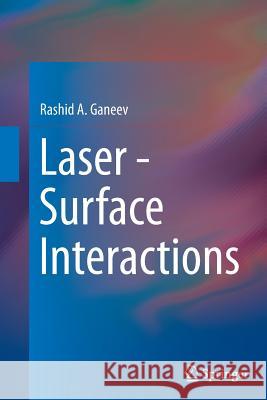Laser - Surface Interactions » książka



Laser - Surface Interactions
ISBN-13: 9789402402445 / Angielski / Miękka / 2016 / 264 str.
Laser - Surface Interactions
ISBN-13: 9789402402445 / Angielski / Miękka / 2016 / 264 str.
(netto: 383,36 VAT: 5%)
Najniższa cena z 30 dni: 385,52
ok. 22 dni roboczych
Dostawa w 2026 r.
Darmowa dostawa!
1 Principles of Lasers and Laser-Surface Interactions. 1.1 Introduction. 1.2 Basics of Lasers. 1.3 Continuous and Pulsed Modes of Operation of Lasers. 1.4 Coherence of Light. 1.5 Modification of Surface Properties. References.
2 Interaction of Low-Power Laser Radiation with Surfaces. 2.1 Laser Rangefinders. 2.2 LIDAR. 2.3 Holography. 2.4 Low-Level Laser Therapy. 2.5 Laser Interferometer Gravitational-Wave Observatories. 2.6 Other Applications of Low-Power Laser-Surface Interactions. References.
3 Analysis of Surface Optical Nonlinearities. 3.1 Application of rz-Scan Technique for Investigation of Nonlinear Refraction of Thin Surface Layers of Sapphire Doped with Ag, Cu, and Au Nanoparticles. 3.2 Reflection z-Scan Measurements of Opaque Semiconductor Thin Films. 3.3 Measurements of Surface Nonlinear Optical Parameters of Nontransparent Materials Using Single-Shot Technique. 3.4 Surface Enhanced Raman Spectroscopy. 3.5 Surface Nanostructuring- and Plasmon-Induced Nonlinearities. References.
4 Laser Cleaning of Art. 4.1 Brief History of the First Steps in Art Conservation Using Lasers. 4.2 Cleaning of Stones. 4.3 Cleaning of Wall Paintings and Woods. 4.4 Cleaning of Metals. 4.5 Cleaning of Paintings. 4.6 Cleaning of Papers and Parchments. References.
5 Nanoripples Formation on the Surfaces. 5.1 Peculiarities of Nanoripples Formation. 5.2 Fabrication of Two-Dimensional Periodic Nanostructures by Two-Beam Interference of Femtosecond Pulses. 5.3 Short Period Nanostructuring of Semiconductor Surfaces Under the Action of Femtosecond Pulses. 5.4 Formation of Different Periodic Nanostructures on Semiconductors. 5.5 Nanoripple Formation from Ultrashort Laser Pulse Irradiation of Semiconductors of Different Bandgaps. 5.6 Extended Homogeneous Nanoripple Formation During Interaction of High-Intensity Few-Cycle Pulses with a Moving Silicon Wafer. 5.7 Concluding Remarks. References.
6 Surface Engineering and Ablation. 6.1 Surface Engineering. 6.2 Laser Engraving and Marking. 6.3 Applications of Intense Laser-Surface Interaction in Defense. 6.4 Analysis of laser-induced ablation of the surfaces. 6.5 Laser Cutting. 6.6 Tattoo Removal by Laser Pulses. References.
7 Ablation of Clusters from Surfaces for Harmonic Generation of Laser Radiation. 7.1 Ablation of Fullerene-Containing Surfaces: the Attractive Method for Harmonic Generation of Laser Radiation. 7.2 Ablation of Metal Nanoparticles from the Surfaces and Efficient Harmonic Generation using 1 kHz Laser. References.
8 X-ray Lasers, Plasma Properties, and Harmonic Generation From Surfaces. 8.1 X-ray Lasers. 8.2 Characterization of Surface Plasmas at High Excitation. 8.3 High-Order Harmonic Generation During Super-Intense Laser-Surface Interaction. References.
Professor Rashid Ganeev for a long time carrying out the systematic studies of the laser-surface interactions. The nonlinear optical parameters (nonlinear refractive indices, nonlinear susceptibilities, multi-photon and saturated absorption coefficients, etc) of various materials, x-ray lasers, nanoripples fabrication, laser rangefinders, laser welding, and hardening of metals, nonlinear optical methods of low-order harmonics generation in various media and other topics are among his scientific interests. He has established his methods to perform high-order harmonic generation in the laser ablation plumes from a solid target through the collaboration with a number of leading laboratories in Japan, Canada, India, Italy, Germany, United Kingdom, Spain, etc.
Rashid Ganeev has published several books related with the optical sciences. He is a first co-author of most of his 260 publications in peer-reviewed journals. In 2002, the International Commission for Optics awarded him the ICO Galileo Galilei Award for the contribution in the nonlinear optics. In 2011, he was awarded the Khwarizmi International Award. In 2008, The World Academy of Sciences (TWAS) elected him a Fellow of TWAS.
This book is about the interaction of laser radiation with various surfaces at variable parameters of radiation. As a basic principle of classification we chose the energetic or intensity level of interaction of laser radiation with the surfaces. These two characteristics of laser radiation are the most important parameters defining entire spectrum of the processes occurring on the surfaces during interaction with electromagnetic waves.
This is a first book containing a whole spectrum of the laser-surface interactions distinguished by the ranges of used laser intensity. It combines the surface response starting from extremely weak laser intensities (~1 W cm-2) up to the relativistic intensities (~1020 W cm-2 and higher). The book provides the basic information about lasers and acquaints the reader with both common applications of laser-surface interactions (laser-related printers, scanners, barcode readers, discs, material processing, military, holography, medicine, etc) and unusual uses of the processes on the surfaces under the action of lasers (art conservation, rangefinders and velocimeters, space and earth explorations, surface engineering and ablation, and others). The scientific applications of laser-surfaces interactions (surface optical nonlinearities, surface enhanced Raman spectroscopy, surface nanostructuring, nanoripples and clusters formation, X-ray lasers and harmonic generation from the surfaces) are discussed from the point of view of the close relations between the properties of surface and matter, which is a cornerstone of most of studies of materials.
The novelty of the approach developed in Laser - Surface Interactions is related with the interconnection of scientific studies with numerous applications of the laser-surface interactions separated in different chapters by the ranges of laser intensities. We present most recent achievements in this field. The book provides valuable information for different ranges of reader's preparedness to the laser-related topics (from unprepared readers, to students, engineers and researchers, professionals and academics).
1997-2025 DolnySlask.com Agencja Internetowa
KrainaKsiazek.PL - Księgarnia Internetowa









